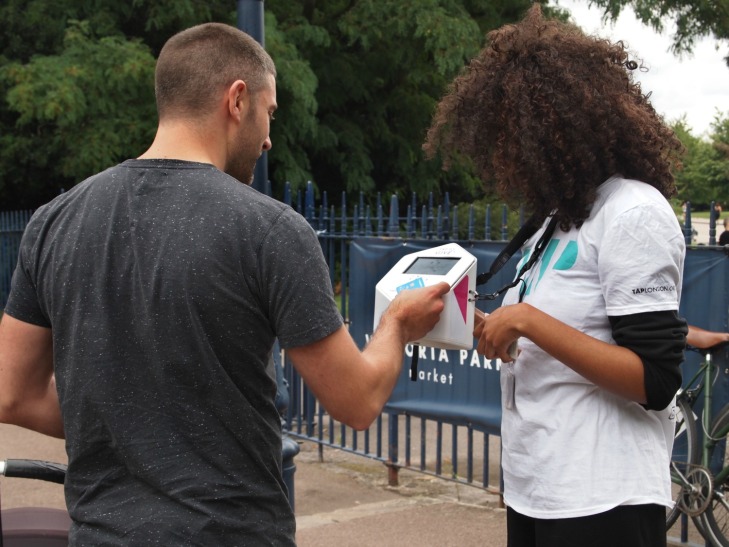As homelessness levels spiral to crisis point, a new not-for-profit is going local to re-engage the donating public.

London is a city of paradoxes. The capital has a booming economy and comparatively high levels of disposable income, but it also encompasses some of the most impoverished areas in the country. Broadly its politics are left-wing, liberal and internationalist, yet at times it can feel like an individualistic and alienating place where people from all walks of life are thrown together to lead rather transient, atomised lives.
Into this complex metropolis steps TAP, a new charity model with localism and community building at its heart. Founded earlier this year by Polly Gilbert and Katie Whitlock, friends who met working at advertising agency J. Walter Thompson, the not-for-profit currently focuses on helping the deprived and homeless in north London boroughs.
Homelessness has been rising steeply in England for several years, with rough sleeping up by 16% in 2016, according to official figures. At the same time, government grants to charities and local councils have been cut back, leading to a dearth of resources for an escalating problem.
It was this issue that occupied Gilbert and Whitlock during a late night discussion about their future career plans. As the conversation turned to the evidently worsening homeless problem in London, the pair hit upon the notion that existing ways of collecting and channelling donations had become cumbersome and outdated.
In particular they thought of ‘chuggers’, those charity representatives who stand on high streets with clipboards in their hands, attempting to get passers-by to stop and commit to a regular direct debit payment. Many see this practice as an annoyance, but in a world of increasingly fast transactions, it also seems increasingly obsolete.
Their solution was TAP, an organisation that uses contactless payment machines to collect micro-donations quickly and efficiently on the street. The pair pitched their idea to the charitable Hunter Foundation and received funding that allowed them to quit their jobs and work on the project full-time.

In its first six months of operations, TAP has focused on building a local network in the boroughs of Hackney and Islington. This has seen it raise funds for four local charities: Shelter from the Storm, which provides emergency shelter for 43 homeless people every night; Spitalfields Crypt Trust, a drop-in centre for vulnerable people; Summer Hype, a summer camp in Hackney supporting children from deprived backgrounds; and Islington Foodbank.
“The whole model is based on the idea that people really want to give locally,” explains Gilbert. “We did quite a lot of research and it showed that 68% of people thought the best way to donate was to give to a local shelter, but out of 380 respondents only one person could name one. Everyone else was naming [St] Mungo’s and Shelter, which are amazing charities but not necessarily local charities.
“So a lack of awareness paired with government funding going down the drain means that all these small charities are really struggling to survive.”
This local perspective extends to TAP’s approach to creativity. As part of the donating experience, people who stop to tap their contactless card on a TAP box receive a thank you card from the fundraiser. The card bears the work of a local artist, as well as some information about the not-for-profit and its work. To date featured work includes that of collage artist Joe Webb and French street artist Zabou.
Making artists an integral part of the experience is another means for TAP to build a local cultural movement around charitable giving. The organisation’s Instagram feed serves as a showcase for both its own charitable work, and the work of local creatives.
“At the moment we’re just putting feelers out there [to recruit more artists for the cards] but the hope is that after a while people will begin to hear about it organically and want to have their work featured,” says Gilbert.

Having secured the contactless payment technology from tech startup GoodBox, TAP is now working out how to scale its model beyond its initial roster of fundraising volunteers. Its plan involves recruiting homeless people to use the machines themselves to collect donations on the street – in other words an updated, high-tech version of The Big Issue model that it could potentially scale-up nationwide in the long-term.
TAP is beginning to roll out small pilots of this plan in London, having recently held discussions with larger charities like Shelter and Business in the Community about the logistics and safeguarding required.
While it is early days, local enthusiasm and momentum is helping to drive the organisation forward. Indeed as the homelessness crisis gets worse, and state support proves increasingly inadequate, new charity models like TAP look set to play an important role in helping communities tackle the problem at a local level.
“Ultimately we’re trying to make charitable giving feel like a fun and enjoyable experience,” says Gilbert. “Both the tech and the creativity are big parts of that.”
